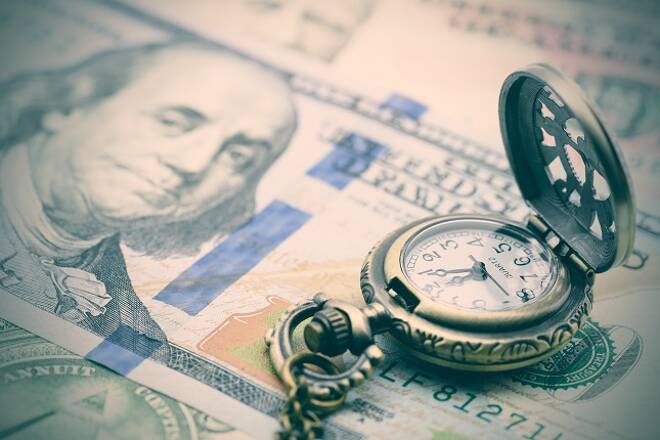Advertisement
Advertisement
U.S. Dollar – Three Factors Signaling Major Top
By:
The combination of the tame inflation report, comments from Fed Chair Powell on cooling global demand and the dovish comments from Fed Vice Chair Clarida stating the Fed is getting closer to neutral, are all signs the Fed may slow its pace of rate hikes and this should be bearish for the U.S. Dollar.
Last week, the U.S. Dollar closed lower against a basket of the currencies. However, it wasn’t an ordinary weakness, it was a technical closing price reversal top, which means the selling was serious. If confirmed this week, we could see the start of a two to three-week correction. Furthermore, if the selling pressure intensifies over the near-term, we could even see a change in trend to down.
Last week, the December U.S. Dollar Index settled at 96.333, down 0.401 or -0.41%.
Although it is often said, that technical analysis precedes the fundamentals, this time the potentially bearish chart pattern appears to be working in sync with a change in the fundamentals.
For years, we’ve read that the dollar is being supported by the divergence in monetary policy between the hawkish U.S. Federal Reserve and the dovish central banks. In other words, rising U.S. interest rates at a time when several central banks are still holding rates at historically low levels, have made the dollar a highly desirable asset.
We’ve also read that at times, the dollar was being treated as a safe-haven asset. The “go to” asset during times of financial stress. This has been a popular investment theme in 2018 because of the heightened volatility in the stock market, political uncertainty in Washington and geopolitical uncertainty over Brexit and the simmering tension between Italy and the European Union. Furthermore, the stress created from the lingering trade dispute between the United States and China, has also draw investors into the relative safety of the U.S. Dollar.
Dollar Struggles at 16-month High
Early last week, the U.S. Dollar hit a 16-month high against a basket of currency. The move occurred without much fanfare because investors have gotten used to the stronger dollar. The early rally was fueled by safe-haven flows ignited by political uncertainties in Europe and fears of a global economic slowdown.
The headlines told us that investor confidence had been eroded by “bitter trade tensions between the United States and China, fears of a no-deal Brexit, and a standoff between Rome and Brussels over Italy’s deficit-deepening budget.”
The headlines also said the U.S. Federal Reserve is set to raise rates by 25 basis points in December. This was even supported by the CME group’s Fed Watch tool, which put the probability of a December rate hike at 75 percent.
Despite all these typically supportive factors, the U.S. Dollar Index posted a potentially bearish closing price reversal top. The chart pattern suggests that the selling is greater than the buying at current price levels.
Three Factors Pressured the U.S. Dollar Last Week
The dollar index started strong on Monday, but many investors discounted the move because it was a U.S. holiday. Tuesday, the dollar index finished lower but inside the previous day’s range. On Wednesday, the selling started. This move set the tone for the rest of the week.
What happened Wednesday that changed investor sentiment?
Inflation May Not Be Overheating
The government reported that U.S. consumer prices increased by the most in nine months in October. The report showed that the increase was supported by gains in the cost of gasoline and rents. This further supported the notion that steadily rising inflation would likely keep the Federal Reserve on track to raise interest rates again in December.
Despite this potentially bullish news, the dollar finished lower. The reason for this was the news was stale. It didn’t reflect the slump in crude oil and gasoline prices. So moving forward, I expect to see overall inflation slow in the months ahead. This news may also be an indication that inflation is not overheating. It may also put less pressure on the Fed to raise rates aggressively in 2019.
Powell Sees Risks Ahead
Comments from Federal Reserve Chairman Jerome Powell may have also weakened the U.S. Dollar. He said on November 14 that the economy is performing well, but he sees potential risks ahead. These risks include a slowdown in global growth, the fading impact from tax cuts and the cumulative weight of the Fed’s own tightening monetary policy.
Fed’s Clarida May Have Sealed Dollar’s Fate
On Friday, the dollar index fell further, leading to the lower weekly close. The greenback sold off after Fed Vice-Chair Richard Clarida cautioned on global growth. Clarida said the Fed is getting closer to neutral and that there is “some evidence” that the world economy is slowing.
The outlook for Dollar Bearish
The combination of the tame inflation report, comments from Fed Chair Powell on cooling global demand and the dovish comments from Fed Vice Chair Clarida stating the Fed is getting closer to neutral, are all signs the Fed may slow its pace of rate hikes and this should be bearish for the U.S. Dollar.
About the Author
James Hyerczykauthor
James Hyerczyk is a U.S. based seasoned technical analyst and educator with over 40 years of experience in market analysis and trading, specializing in chart patterns and price movement. He is the author of two books on technical analysis and has a background in both futures and stock markets.
Did you find this article useful?
Latest news and analysis
Advertisement
